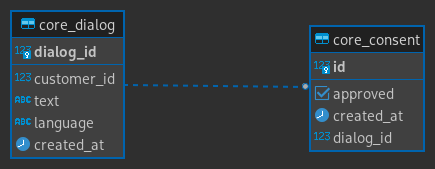The application is based on Django + Django Rest Framework and
PostgreSQL and runs inside 2 Docker containers defined in the
docker-compose.yml file.
Django is a full-stack open-source web framework and follows a Model View Template type of architecture. It is comprised of a set of components and modules that aids in faster development.
Django REST framework is a powerful and flexible toolkit for building Web APIs. Its main benefit is that it makes serialization very easy.
A classic RDBMS was chosen for data storage: PostgreSQL (running in a docker container).
Since this application does not require extremely low response times and should not have very large spikes in traffic or require real-time analytics the need to use an in-memory database was considered unnecessary.
PostgreSQL was chosen because it is one of the most popular and well-regarded open-source relational databases in the world. However, due to the fact that Django supports multiple database types and uses an ORM for abstraction, changing the database is always possible with little effort.
The datamodel is composed by two tables. Dialog and Consent.
The Dialog table represent the customer’s input during their dialog
with the chatbot. Although the endpoint is called “data” it has been
avoided to use a generic name like “data” for the table in favor of
“dialog” that better describes its content.
The dialog_id has been defined as the primary key since it should be
possible to uniquely identify a Dialog based on its id.
Since the requirements call for using a POST consents/ endpoint to
record the user’s consent and the http POST verb is commonly used to
create a new resource, the consent is represented by a separate Consent
table that has a one-to-one relationship with Dialog. An alternative
might have been to record the consent as a Dialog field and use a
PATCH data/ endpoint to update it.
The customer could also be stored in a separate table, especially if additional customer data needs to be recorded.
To run the application run the docker-compose up command from the top
level directory of the repository and run the Django migrations
to the database
docker-compose up -d
docker-compose exec web python manage.py migrateThis will start the Django app listening on http://localhost:8000
To insert new data, the endpoint POST /data/${customerId}/${dialogId} is defined.
It can be used like this:
curl -X POST http://127.0.0.1:8000/data/1/1 --data '{"text": "Hello, World", "language": "EN"}' -H "Content-Type:application/json"An alternative would have been to pass the “dialogId” and the “customerId” paramenters used for the creation, in the payload, instead of as path parameters, avoiding to use a url that, at the time it is called, represents a resource that has not yet been created.
The POST /consents/${dialogId} endpoint is used to set the user’s
consent to store and use their data.
It can be used like this:
curl -X POST http://127.0.0.1:8000/consents/1 --data '{"approved": "true"}' -H "Content-Type:application/json"An alternative, mentioned earlier could have been to do a PATCH call on the Dialog updating a single field (or directly add the consens parameter to the body of the Dialog creation POST request).
The GET /data/(?language=${language}|customerId=${customerId})
endpoint is used to retrieve stored dialogs for which there is the user’s
consent. It is paginated and sorted by most recent data first. The
pagination accepts a single number page number in the request query
parameters e.g. ?page=4 (100 elements per page).
# The query params are optional
curl -X GET http://127.0.0.1:8000/data/?language="EN"&customerId=1This will return a paginated response structured like:
{
"count":1,
"next":null,
"previous":null,
"results":
[{
"customerId":1,
"dialogId":2,
"text":"Hello, World",
"language":"EN"
}]
}To run the automated tests, run the following command from the top level directory of the repository
docker-compose exec web python manage.py testSince the data is written to the application and only later retrieved for processing by data scientists, in case of a large number of clients recording data at the same time, a solution with an in-memory database (e.g. Redis) where the data is written to redis first and then push it out to Postgres later (maybe only when the consent is given), could help to ensure good write performances and less load on the RDBMS.
Since this is a prototype, there are some infrastructure aspects that need to be investigated further if the project goes into production. Some of these aspects are:
- Using a real production server to serve Django, instead of the development server included in Django.
- Restricting access to the application.
- Configure the database in more detail.
